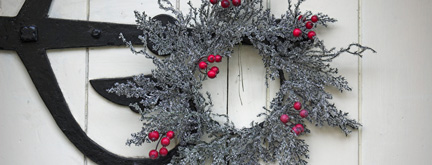You probably adorn your door with a wreath during the holidays. But do you know why? Here’s a little history lesson to help you learn the significance of the holiday wreath.
A Little Wreath History
Persian Perhaps?
Many historians date wreaths back to the Persian Empire where royalty and the upper class wore fabric versions adorned with jewels.
Crowning Glory
In Ancient Greece, handmade laurel wreaths were used as crowns for athletes, military heroes and even at weddings as a symbol of victory and pride.
Evergreen Eternal
As coniferous trees remain alive during the winter months, Egyptians, Hebrew and Chinese cultures used evergreen branches to symbolize eternal life. Later, Catholics and Christians took that same symbolism relating it to Christ.
Table or Door Decor
The popularity of the wreath grew along with the Christian faith. Originally, however, the wreath sat flat on a table and was adorned with five candles—four in the branches and one in the middle. Used in the Advent season leading up to the 25th, the candles were individually lit each week until the centre one was set aglow on Christmas Day.
Holiday Greetings
A wreath hanging on the door is a symbol of welcome to guests.
A Family Affair
It is believed that some Europeans used wreaths on their doors as symbols of their family identity, not unlike a family crest. Items from their individual gardens (like grapevines, flowers or produce) were added as a touch of individuality. It was a family tradition to build these wreaths together. A fun holiday activity, perhaps?
Twisted Stuff
The word ‘wreath’ comes from the old English word “writhen” which means twist, or writhe, relating to its circular form.
What Does it Mean?
Traditional materials used weren’t just randomly chosen. Different plants had different significance. While the evergreen branches were about eternal life, laurel leaves represent victory over suffering, pine, holly and yew symbolize immortality and cedar means strength and healing. Other classic adornments include pinecones and nuts, which are symbols of the Resurrection.
Holy Holly
The traditional holly wreath has great significance to Christians. The pointed leaves are reminiscent of Jesus’ crown of thorns while the berries represent his blood. There is even a legend that his cross was made of holly.
Getting Creative
You can take inspiration from the traditional and add your own flare (candy canes anyone?) or, you can jazz things up a bit. Here are some fun suggestions:
Go Plant-less
Buy a bunch of plain Christmas ball ornaments or pull out all those old tree decorations that you can’t bear to throw away. Using a wreath base and a hot glue gun, get creative and make an ornamental collage.
A holiday Pic
Pull out some of those old family photos (or print new ones) and paste them on to cardboard backings. Using a wreath base, randomly glue on for a wreath photo album.
Box It Up
Wrap small boxes from jewellery or cut Styrofoam into cubes to create mini presents. Glue them on a wreath base for a gifted decoration.
Edible Adornment
Use homemade gingerbread to create an edible wreath (or mini versions). Roll out the dough, cook in one large circle until it’s soft, but firm. Cut out into a large wreath shape and finish baking. Cool, decorate and enjoy (if you haven’t already eaten it)!
Source: HGTV Canada – Holidays

